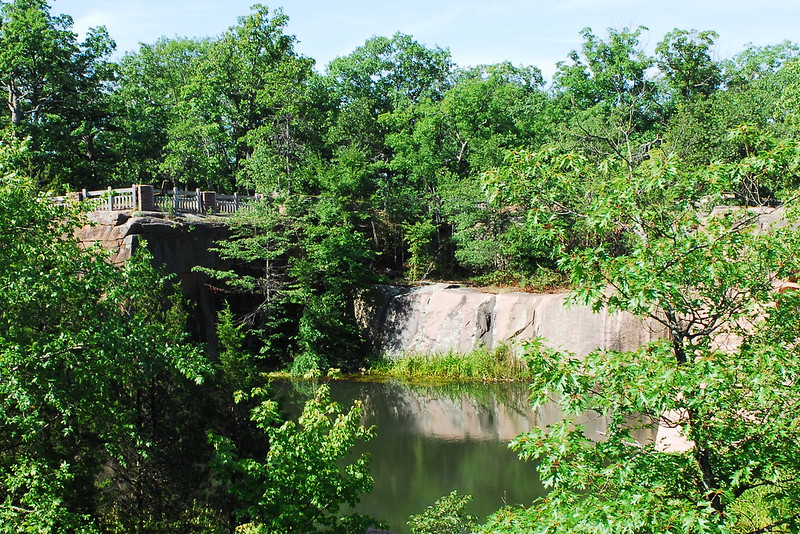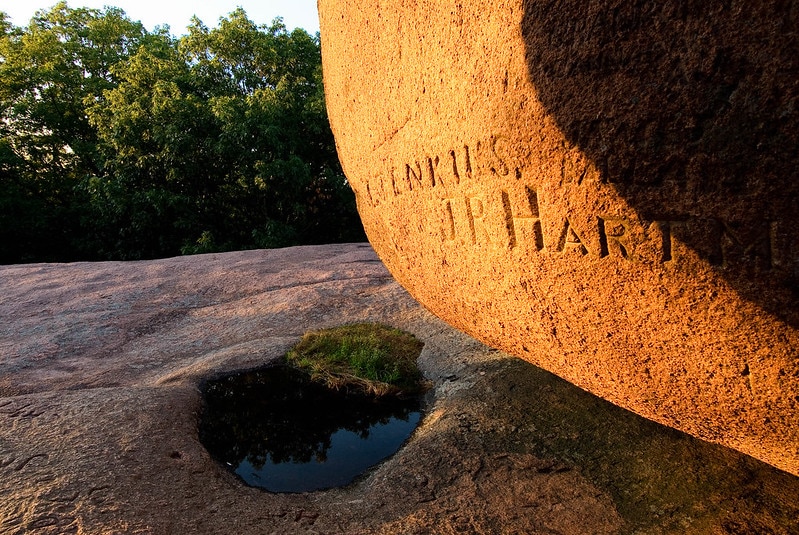Granite “elephants” came to be due to uplift and erosion. Make plans to visit today. You can follow a Braille trail and have a snack on the picnic tables hidden among the rocks. There is so much to see and learn among these “elephants.”

ELEPHANT ROCKS STATE PARK PROVIDES a veritable geological classroom. Here the visitor can see and touch some of the oldest rocks on the earth’s surface. Here one can learn how even the hardest rocks remain at the mercy of the elements. And here one can contemplate the origin of the “elephants,” the Ozarks, and the earth itself.
Geologists tell us that Missouri’s red granite is about 1.5 billion years old. The granite was formed by the slow cooling of molten rock, called magma, as it intruded into the earth’s crust. During this slow cooling, vertical and horizontal cracks, called joints, developed in the rock. The vertical joints developed in two different directional sets: one set trends toward the northeast, the other toward the northwest. Where the joints crossed each other, the granite separated into a huge stack of oblong blocks—all while still buried beneath the surface and further covered through the eons by layers of rock formed from sediments in ancient seas.

The Ozarks—and the elephants we know today—are the product of uplift and erosion. As the Ozarks warped upward into a gigantic dome and eroded over hundreds of millions of years, the granite blocks were brought closer to the surface. A combination of groundwater and chemical weathering began to decay the rock near the joints and fractures. Corners began to round, like the edges of a melting ice cube, and the spaces between filled with sand and grit, called grus. Once the fractured granite was exposed at the surface by further erosion, natural weathering by rainwater, freezing, thawing, sunlight, and wind continued rounding the blocks and removing the grus, some of which may still be seen between exposed joints. Even trees and shrubs, growing in the cracks, contribute to the slow disintegration of the ancient granite, one of the hardest rocks in the known universe. As weathering and erosion continue relentlessly over the eons, more of the herd yet buried beneath the surface may be freed.
These pachyderms remain fascinating despite the fact that the geologic explanation puts to rest more fanciful theories of their origin. The elephants were not moved here, either by giants or by glaciers. Glaciers can carry boulders and leave them behind as the glaciers retreat—such boulders are called erratics—but the glaciers never reached as far south as the St. Francois Mountains. No, the elephants were formed right where they stand—residual boulders resisting the elements. At Elephant Rocks State Park in Iron County, one can see all the various stages in the formation and weathering of boulders. The largest, which some know as Dumbo, leader of the herd, stands some twenty-seven feet tall and weighs an estimated 680 tons.
The state park contains several old granite quarries and is surrounded by even more; the town adjacent to the park is named Graniteville. Local homes and walls and gravestones are often made of the pink Missouri stone. The largest granite quarry, just outside the park, was opened in 1869. It has furnished paving stones for some of St. Louis’s streets, and they are still visible in the Laclede’s Landing area. It also provided massive blocks for the piers of the Eads Bridge across the Mississippi at St. Louis and for the state capitols of Iowa and Illinois. B. Gratz Brown, who owned one of the quarries and was governor in 1871 when the state’s impressive Second Empire-style governor’s mansion was built in Jefferson City, donated four turned pink granite columns for the portico. Other quarries have furnished stone for major buildings in St. Louis and many other cities.

Missourians have been clambering around on the elephant rocks since long before the area became a state park, stretching back to the earliest white settlers, and probably Native Americans before them. By the 1870s, St. Louis artists were producing “views of the elephants,” and the beloved old weathered boulders were the inspiration for the lifelike settings developed to house and display the hoofed animals at the St. Louis Zoo, built as a part of the 1904 World’s Fair.
The area was suggested for a state park in 1924, but fourteen years later when Secretary of the Interior Harold Ickes came to Missouri to dedicate Babler Memorial State Park near St. Louis, he lamented, “Years ago this state should have set aside the Elephant Rocks, which have now been hammered to pieces.” Fortunately, he was not entirely correct, and in 1967 a remnant of the site came into the state park system, fittingly enough through the generosity of a geologist who loved the rocks and appreciated their significance. John Stafford Brown, retired chief geologist for St. Joseph Lead Company, purchased 120 acres and presented it to the state. The small park of only 134 acres officially opened three years later in 1970 and now welcomes some 400,000 visitors a year.
State park planners have done an excellent job of designing the trails and other necessary improvements so that they have minimal effect on the natural resource. Elephant Rocks State Park was also the first park in Missouri to feature a Braille trail. Opened in 1973, the trail was specially designed to provide access for people with visual and physical disabilities. It features a paved surface with gentle grades and guide ropes or railings where necessary. Astroturf patches in the path alert users to Braille signs and tactile opportunities nearby, including a blindman’s bluff play area. Also noteworthy are the picnic tables scattered among the rocks instead of massed in the open; they nearly disappear in the landscape while providing privacy for those using them.

At the center of the park, encircled by the Braille trail, is the seven-acre Elephant Rocks Natural Area. It is geologically an isolated hill—or tor—and is by far the most significant granite tor in Missouri. A spur off the trail leads to an overlook of an area where granite was quarried until the early 1900s. Another half-mile loop trail leads to the ruins of an old granite-block engine house where railroad cars, engines, and the steam engine used in quarry operations were serviced.
But it is the rocks that beckon, urging you to experience the joy of exploring or to ponder their origins. Here, among the ancient boulders of Elephant Rocks State Park, you can lose yourself in the weathered maze and ponder that you’re standing in the very core of the Ozarks.
Elephant Rocks State Park
A HUNDRED YEARS TO GROW AN INCH
A measure of the slowness of the process of weathering these giants may be seen in the lichens that cover some of the boulders. Some lichens require as much as a hundred years to grow an inch, but they can be crushed by human hands and then washed away by the next rain. The elephants no longer sport as many of these elegant timepieces as they once did.
ELEPHANT ROCKS STATE PARK • 7406 HIGHWAY 21, BELLEVIEW
Related Posts
Missouri State Library Established
On January 22, 1829, the Missouri State Library was established in Jefferson City.
Meet 5 of Our State’s Female Winemakers
Females fuel America’s wine industry: women buy 57 percent of the wine consumed in this country. But the ladies are not only buying and drinking wine; they’re making it, too.



